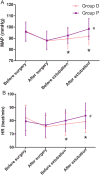Effects of Dexmedetomidine or Propofol on Postoperative Oxygenation Index During Invasive Ventilation in Patients After off-Pump Coronary Artery Bypass Grafting: a Single-Center Retrospective Study
- PMID: 40607013
- PMCID: PMC12214473
- DOI: 10.2147/IJGM.S524691
Effects of Dexmedetomidine or Propofol on Postoperative Oxygenation Index During Invasive Ventilation in Patients After off-Pump Coronary Artery Bypass Grafting: a Single-Center Retrospective Study
Abstract
Purpose: This study aimed to compare the effects of dexmedetomidine (DEX) and propofol on patients undergoing invasive ventilation after off-pump coronary artery bypass grafting (OPCABG) with regard to oxygenation index (OI) (PaO2/FiO2), hemodynamic changes, extubation time, and adverse reactions.
Patients and methods: This single-center retrospective study included 195 patients admitted to the cardiovascular surgery intensive care unit (CVICU) after OPCABG between January 2022 and June 2024. According to the postoperative invasive mechanical ventilation for sedation with only DEX or propofol, the patients were classified into groups D and P. The primary outcome was oxygenation index (OI) before and after extubation. The secondary outcomes included mean arterial pressure (MAP) and heart rate (HR) before and after extubation, extubation time, and adverse reactions after surgery.
Results: DEX was significantly associated with an increased likelihood of OI before and after extubation composed to propofol (P < 0.05). MAP and HR after extubation were significantly higher than before extubation in Group P (P < 0.05). However, there were no significant differences between before and after extubation in Group D (P < 0.05). Furthermore, MAP and HR were significantly lower in Group D than in Group P before and after extubation (P < 0.05). In addition, the extubation time was significantly shorter in Group D in comparison of propofol (P < 0.05). Additionally, the incidence of delirium and severe cough at extubation after surgery was significantly lower in Group D than in Group P (P < 0.05).
Conclusion: DEX may support satisfactory OI, good hemodynamic stability, rapid extubation time, and a lower incidence of adverse reactions for sedation of mechanically ventilated patients following OPCABG surgery compared to propofol, although the difference with OI did not reach the MCID.
Keywords: dexmedetomidine; invasive ventilation; off-pump coronary artery bypass grafting; oxygenation index; propofol.
© 2025 Li et al.
Conflict of interest statement
The authors state no conflicts of interest in this work.
Figures




Similar articles
-
Intravenous magnesium sulphate and sotalol for prevention of atrial fibrillation after coronary artery bypass surgery: a systematic review and economic evaluation.Health Technol Assess. 2008 Jun;12(28):iii-iv, ix-95. doi: 10.3310/hta12280. Health Technol Assess. 2008. PMID: 18547499
-
Positioning for acute respiratory distress in hospitalised infants and children.Cochrane Database Syst Rev. 2022 Jun 6;6(6):CD003645. doi: 10.1002/14651858.CD003645.pub4. Cochrane Database Syst Rev. 2022. PMID: 35661343 Free PMC article.
-
Alpha-2 agonists for sedation of mechanically ventilated adults in intensive care units: a systematic review.Health Technol Assess. 2016 Mar;20(25):v-xx, 1-117. doi: 10.3310/hta20250. Health Technol Assess. 2016. PMID: 27035758 Free PMC article.
-
Safety and efficacy of low-dose esketamine weakly opioidized anesthesia in elderly patients with lumbar spinal stenosis undergoing surgery: a prospective, double-blind randomized controlled trial.BMC Anesthesiol. 2025 Feb 5;25(1):57. doi: 10.1186/s12871-025-02908-3. BMC Anesthesiol. 2025. PMID: 39910473 Free PMC article. Clinical Trial.
-
Pulmonary artery perfusion versus no pulmonary per-fusion during cardiopulmonary bypass.Dan Med J. 2018 Mar;65(3):B5473. Dan Med J. 2018. PMID: 29510817
References
-
- Nguyen J, Nacpil N. Effectiveness of dexmedetomidine versus propofol on extubation times, length of stay and mortality rates in adult cardiac surgery patients: a systematic review and meta-analysis. JBI Database System Rev Implement Rep. 2018;16(5):1220–1239. doi: 10.11124/JBISRIR-2017-003488 - DOI - PubMed
LinkOut - more resources
Full Text Sources

